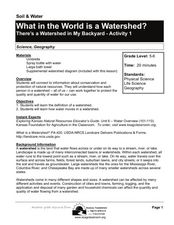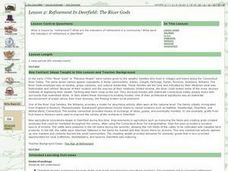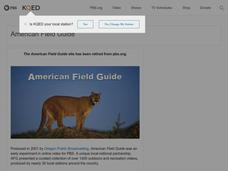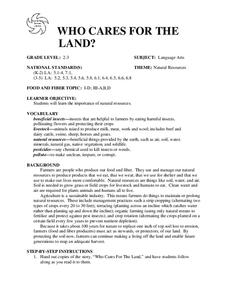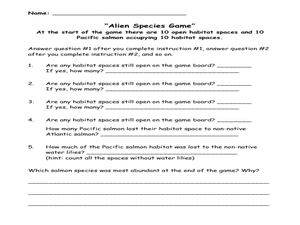Curated OER
What's Organic?
Students discuss background information presented by the teacher and read dictionary definitions for the words "organic" and "synthetic." In this gardengin instructional activity, students complete a worksheet on the material. Students...
Curated OER
The Sweet Connection
Students use maps to find what crops are dominant in areas where honey bees are raised and discuss possible correlations. They mark the top ten honey- producing states on a US map.
Curated OER
Genetically Modified Foods in Perspective
Students research the concept of genetically modified foods. The purpose of the research is to increase science content knowledge and comprehension of the controversy surrounding the subject.
Curated OER
DNA: The Human Body Recipe
Pupils describe DNA and the roles in which engineers are involved with the human body. In this DNA lesson students participate in a class demonstration.
Curated OER
Windmills and Blogs: The Impact of Technology in Rural Peru
How does technology affect a community? Research the benefits and consequences of technology in rural Peru. In this technology lesson, learners discuss how the effects of technology. They view a PowerPoint and learn about the Peace...
Curated OER
Sorting
Young scholars experience sorting. In this organization lesson, students play a computer sorting game called "Flood Game" on the "Between the Lions" website. Young scholars visit a library and observe and discuss book organization....
Curated OER
Paper or Plastic: Exploring Renewable Resources.
Students discuss, develop, invent, and implement a plan for making informed personal economic decisions about renewable resources.
Curated OER
Hatching chickens
Students recognize the need for gentle care of eggs. In this chicken hatching lesson, students observe the process of incubating eggs for hatching. Students find the materials needed to properly care for the chicks. Students complete a...
Curated OER
What in the World Is a Watershed?
Young scholars discover the role of a watershed. For this geography lesson, students are shown a diagram of a watershed and discuss the definition of a watershed. Young scholars demonstrate the role of a watershed by using an umbrella...
Curated OER
An Egg is Quiet
Students discover information about animal eggs by reading the book, An Egg is Quiet. In this animal science lesson, students research different animals to find out what their eggs look like. Students use a provided chart to...
Curated OER
Refinement in Deerfield: The River Gods
Students research the town of Deerfield, CT and its River God families to show how the middle class developed in the Connecticut River Valley.
Curated OER
An Ancient Revolution: The Written Word
Students examine the Bible, one of the earliest written sources, as a compilation of narratives, and search the resources on the HERITAGE DVD-ROM for historical "proof" as well as create their own stories and scripts based on ancient...
Curated OER
Picture Perfect Pyramid
Students investigate the concept of the food pyramid. The lesson includes background information for the teacher to lecture students about the food pyramid. They construct a model of the pyramid using cereal boxes. The projects could...
Curated OER
Flowers and Plants
Students are assigned to bring five flowers. They explore flowers to distinguish different physical features of flowers. They compare and contrast different flowers to determine what features they have in common. Students develop an...
Curated OER
WHO CARES FOR THE LAND?
Learners explore the importance of natural resources. They are given copies of the story, "Who Cares For The Land," and students follow
along as the teacher reads it. Learners identify the key points in the story. (Soil, water and air...
Curated OER
EGG MAZE: COUNTING BY TWOS, THREES AND FIVES
Students successfully count by twos, threes and fives, using pictures of eggs and poultry as points of interest. They orally review the types of counting (twos, threes, or fives). Students are introduced the idea of a dozen eggs.
Curated OER
Pollinator Habitats
Students read and discuss background information included with this instructional activity. They brainstorm the best sources for developing a list of native or migratory pollinators. Students work in groups to design habitats based on...
Curated OER
Soil, Designer Soil: From Rainforests to the Prairie
Students explore the role and importance of soil in the ecosystem. In this Science and Social Studies lesson plan, students complete an experiment using various kinds of soil and clay and then examine how soil has a direct impact...
Curated OER
What is the history of rice in the United States?
Fifth graders become familiar with the history of rice and create a board game. In this rice lesson, 5th graders understand the history of rice through the playing of a game. Students use vocabulary words related to the...
Curated OER
Mangrove Loss Faster than Land-Based Forests
Young scholars explore the reasons Mangrove forests are in jeopardy. In this lesson, students read an article that discusses specific facts on Mangrove forests, then complete numerous activities that reinforce the information, such...
Curated OER
Recycle, Reduce, Reuse and Save a Tree
Students examine how to save and protect trees. For this conservation lesson, students read books about the usefulness of trees, write ideas in their journals about how trees can be used, and make a book of ways to protect trees.
Curated OER
Sticks, Stones, Sinews and Stuff: How Early People Used the Environment to Meet Basic Needs
Students create an artifact. For this early survival lesson, students use found objects to create an artifact that could have been used to help early people meet their basic needs.
Curated OER
Salmon and the Non-Native Species
Students investigate the affect of non-native species on Pacific Salmon. In this non-native species and Pacific Salmon lesson, students participate in a competition and habitat loss game. They play the game in groups, while answering...
Curated OER
Fish In a Bottle
Students work together to build their own fish ecosystems. As a class, they share their prior knowledge about catfish and use a diagram to label its body parts. They record their observations of the ecosystem and determine what they...








